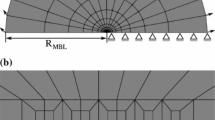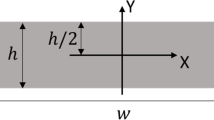Abstract
Scale-dependent stress intensity factors in an anti-plane cracked orthotropic material layer are evaluated using strain gradient theory. Both volumetric and surface strain gradient material characteristic lengths represented as l and \(l^{'}\), respectively, are employed to obtain semi-analytical solutions. The surface strain gradient effect is considered for both positive and negative \(l^{'}\) values. The layer edges are assumed stress-free and oriented parallel to the crack plane. The presence of orthotropy can either increase or decrease the stress intensity factors depending on if it is greater or smaller than unity. The volumetric strain gradient effect reduces the stress intensity factor and it is more pronounced for smaller layer thickness. It was found that the negative surface gradient leads to a more complaint crack, while the positive surface gradient increases crack stiffness. Overall, the surface gradient effect is less significant in comparison with the volumetric gradient effect.





Similar content being viewed by others
References
Fleck, N., Hutchinson, J.: Strain Gradient Plasticity (Advances in Applied Mechanics), vol. 33. Elsevier, New York (1997)
Lam, D.C.C., Yang, F., Chong, A., Wang, J., Tong, P.: Experiments and theory in strain gradient elasticity. J. Mech. Phys. Solids 51(13), 1477–1508 (2003)
McFarland, A.W., Colton, J.S.: Role of material microstructure in plate stiffness with relevance to microcantilever sensors. J. Micromecha. Microeng. 15(10), 1060 (2005)
Forest, S.: Mechanics of generalized continua: construction by homogenizaton. Le Journal de Physique IV. 8(PR4): p. Pr4-39-Pr4-48 (1998)
Forest, S.: Homogenization Methods and the Mechanics of Generalized continua, International Seminar on Geometry, Continuum and Microstructure, organized by G, pp. 28–29. Maugin, Paris (1997)
Mühlhaus, E.H.: Continuum Models for Materials with Microstructure. Wiley, New York (1995)
Forest, S.: Homogenization methods and mechanics of generalized continua-part 2. Theor. Appl. Mech. 28–29, 113–144 (2002)
Abali, B.E., Müller, W.H., dell’Isola, F.: Theory and computation of higher gradient elasticity theories based on action principles. Arch. Appl. Mech. 87(14), 1495–1510 (2017)
Auffray, N., Dell’Isola, F., Eremeyev, V., Madeo, A., Rosi, G.: Analytical continuum mechanics à la Hamilton–Piola least action principle for second gradient continua and capillary fluids. Math. Mech. Solids 20(9), 375–417 (2015)
Pideri, C., Seppecher, P.: A second gradient material resulting from the homogenization of an heterogeneous linear elastic medium. Contin. Mech. Thermodyn. 9(10), 241–257 (1997)
Bertram, A., Forest, S.: The thermodynamics of gradient elastoplasticity. Contin. Mech. Thermodyn. 26(8), 269–286 (2014)
Alibert, J.J., Della Corte, A.: Second-gradient continua as homogenized limit of pantographic microstructured plates: a rigorous proof. Zeitschrift für angewandte Mathematik und Physik 66(10), 2855–2870 (2015)
Dell’Isola, F., Andreaus, U., Placidi, L.: At the origins and in the vanguard of peridynamics, non-local and higher-gradient continuum mechanics: an underestimated and still topical contribution of Gabrio Piola. Math. Mech. Solids 20(13), 887–928 (2015)
Fritzen, F., Forest, S., Böhlke, T., Kondo, D., Kanit, T.: Computational homogenization of elasto-plastic porous metals. Int. J. Plast. 29, 102–119 (2012)
Geers, M.G., Kouznetsova, V.G., Brekelmans, W.: Multi-scale computational homogenization: trends and challenges. J. Comput. Appl. Math. 234(12), 2175–2182 (2010)
Khakalo, S., Niiranen, J.: Form II of Mindlin’s second strain gradient theory of elasticity with a simplification: for materials and structures from nano-to macro-scales. Eur. J. Mech.-A/Solids 71, 292–319 (2018)
Rahali, Y., Giorgio, I., Gnahhoffer, J., F. Dell’Isola, F.: Homogenization à la Piola produces second gradient continuum models for linear pantographic lattices. Int. J. Eng. Sci. 97, 148–172 (2015)
Schröder, J., Neff, P., Balzani, D.: A variational approach for materially stable anisotropic hyperelasticity. Int. J. Solids Struct. 42(18), 4352–4371 (2005)
Eringen, A.C., Edelen, D.: On nonlocal elasticity. Int. J. Eng. Sci. 10(8), 233–248 (1972)
Yang, F., Chong, A., Lam, D.C.C., Tong, P.: Couple stress based strain gradient theory for elasticity. Int. J. Solids Struct. 39(15), 2731–2743 (2002)
Aifantis, E.C.: On the role of gradients in the localization of deformation and fracture. Int. J. Eng. Sci. 30(15), 1279–1299 (1992)
Aifantis, E.C.: Update on a class of gradient theories. Mech. Mater. 35(3–6), 259–280 (2003)
Mindlin, R.D.: Microstructure in Linear Elasticity. Dept of Civil Engineering and Engineering Mechanics, Columbia Univ, New York (1963)
Mindlin, R.D.: Second gradient of strain and surface-tension in linear elasticity. Int. J. Solids Struct. 1(9), 417–438 (1965)
Vardoulakis, I., Exadaktylos, G., Aifantis, E.: Gradient elasticity with surface energy: mode-III crack problem. Int. J. Solids Struct. 33(33), 4531–4559 (1996)
Chan, Y.S., Paulino, G.H. Fannjiang, A.C.: Gradient elasticity theory for mode III fracture in functionally graded materials-part II: crack parallel to the material gradation. J. Appl. Mech. 75(11) (2008)
Paulino, G.H., Fannjiang, A.C., Chan, Y.S.: Gradient elasticity theory for mode III fracture in functionally graded materials-part I: crack perpendicular to the material gradation. J. Appl. Mech. 70(9), 531–542 (2003)
Polizzotto, C.: A note on the higher order strain and stress tensors within deformation gradient elasticity theories: Physical interpretations and comparisons. Int. J. Solids Struct. 90, 116–121 (2016)
Aifantis, E.C.: A note on gradient elasticity and nonsingular crack fields. J. Mech. Behav. Mater. 20, 103–105 (2011)
Aifantis, E.C.: Internal length gradient (ILG) material mechanics across scales and disciplines. Advances in Applied Mechanics, pp. 1–110. Elsevier, Amsterdam (2016)
Sulem, J., Vardoulakis, I.: Bifurcation Analysis in Geomechanics. CRC Press, Boca Raton (1995)
Giannakopoulos, A., Stamoulis, K.: Structural analysis of gradient elastic components. Int. J. Solids Struct. 44(15), 3440–3451 (2007)
Joseph, R.P., Wang, B.L., Samali, B.: Size effects on double cantilever beam fracture mechanics specimen based on strain gradient theory. Eng. Fract. Mech. 169, 309–320 (2017)
Joseph, R.P.: Scale-Dependent Fracture in Gradient Elastic Materials. Western Sydney University, Sydney (2018)
Joseph, R.P., Wang, B.L., Samali, B.: Strain gradient fracture in an anti-plane cracked material layer. Int. J. Solids Struct. 146, 214–223 (2018)
Joseph, R.P., Wang, B.L., Samali, B.: Large deformation and strain gradient fracture analysis of double cantilever beams with piezoelectric effect. J. Eng. Mech. 144(13), 04018071 (2018)
Joseph, R.P., Wang, B.L., Samali, B.: Size-dependent stress intensity factors in a gradient elastic double cantilever beam with surface effects. Arch. Appl. Mech. 88(15), 1815–1828 (2018)
Joseph, R.P., Chunwei, Zhang, Wang, B., Samali, B.: Fracture analysis of flexoelectric double cantilever beams based on the strain gradient theory. Compos. Struct. 202, 1322–1329 (2018)
Wang, G.F., Feng, X.Q., Wang, T.J., Gao, W.: Surface effects on the near-tip stresses for mode-I and mode-III cracks. J. Appl. Mech. 75(1) (2008)
Fannjiang, A.C., Paulino, G.H., Chan, Y.S.: Strain gradient elasticity for antiplane shear cracks: a hypersingular integrodifferential equation approach. SIAM J. Appl. Math. 62(8), 1066–1091 (2002)
Mousavi, S.M., Aifantis, E.: A note on dislocation-based mode III gradient elastic fracture mechanics. J. Mech. Behav. Mater. 24(3–4), 115–119 (2015)
Karimipour, I., Fotuhi, A.R.: Anti-plane analysis of an infinite plane with multiple cracks based on strain gradient theory. Acta Mechanica 228(10), 1793–1817 (2017)
Yang, F.: Exact solution for a finite length crack in a strip under general antiplane loading. Int. J. Fract. 87(7), L57–L64 (1997)
Singh, B., Moodie, T.B.: Closed-form solutions for finite length crack moving in a strip under anti-plane shear stress. Acta Mechanica 38(1–2), 99–109 (1981)
Tait, R., Moodie, T.B.: On a problem in the dynamic theory of cracks. Q. Appl. Math. 39(8), 419–423 (1981)
Li, X.F.: Closed-form solution for a mode-III interface crack between two bonded dissimilar elastic layers. Int. J. Fract. 109(7), 3–8 (2001)
Wang, B.L., Mai, Y.W.: Closed-form solution for an antiplane interface crack between two dissimilar magnetoelectroelastic layers. J. Appl. Mech. 73, 281–290 (2006)
Sih, G., Chen, E.: Mechanics of Fracture 6: Cracks in Composite Materials. Martinus Nijhoff Publishers, The Hague (1981)
Exadaktylos, G.: Gradient elasticity with surface energy: mode-I crack problem. Int. J. Solids Struct. 35(5–6), 421–456 (1998)
Exadaktylos, G.E., Vardoulakis, I.: Microstructure in linear elasticity and scale effects: a reconsideration of basic rock mechanics and rock fracture mechanics. Tectonophysics 335(1–2), 81–109 (2001)
Copson, E.: On certain dual integral equations. Glasg. Math. J. 5(1), 21–24 (1961)
Atkinson, K., Shampine, L.: Solving Fredholm integral equations of the second kind in MATLAB. ACM Trans. Math. Software. 34(9) (2007)
Mathews, J.H., Fink, K.D.: Numerical Methods Using MATLAB, vol. 4. Pearson Prentice Hall, Upper Saddle River (2004)
Author information
Authors and Affiliations
Corresponding author
Additional information
Publisher's Note
Springer Nature remains neutral with regard to jurisdictional claims in published maps and institutional affiliations.
Appendices
Appendix
Classical case
The conditions at the crack line (\(y =\) 0) are given as
The application of integral transform technique on the displacement solution that satisfies the non-trivial equilibrium equation in z-direction \(\left( {\partial ^{2}w_{z} /\partial x^{2}+\partial ^{2}w_{z} /\partial y^{2}=0} \right) \)for the orthotropic material is written as [48]
with the aid of (A.3), \(\tau _{yz} =G\left( {\partial w_{z} /\partial y} \right) \)may be expanded as
Here, \(c_{44} \) is the shear modulus of the material, A(s) and B(s) are constants to be determined from the boundary conditions. For stress-free boundaries, the shear stresses at the upper and lower edge (i.e., \(y =\pm h)\) of the layer for all values of x would be zero. Mathematically, it may be written as
Due to geometrical symmetry, the only upper half of the layer is considered. From (A.4) and (A.5), it may be shown that \(B(s)=e^{-(2sh/\sqrt{\beta })}A(s)\), so if \(A(s)=E(s)/(1+e^{-(2sh/\sqrt{\beta })})\) then \(B(s)=e^{-(2sh/\sqrt{\beta })}E(s)/(1+e^{-(2sh/\sqrt{\beta })})\), where E(s) is an unknown function to be determined. The conditions (A.1) and (A.2) are satisfied if E(s) is the solution of dual integral equations given as
With \(F_{sc} (s)=(1-e^{-(2sh/\sqrt{\beta })})/(1+e^{-(2sh/\sqrt{\beta })})\), here “sc” in subscript represents the “stress-free boundaries & classical” case.
Rights and permissions
About this article
Cite this article
Joseph, R.P., Zhang, C., Wang, B.L. et al. Analyzing size effects in a cracked orthotropic layer under antiplane shear loading. Arch Appl Mech 91, 1097–1112 (2021). https://doi.org/10.1007/s00419-020-01812-1
Received:
Accepted:
Published:
Issue Date:
DOI: https://doi.org/10.1007/s00419-020-01812-1




